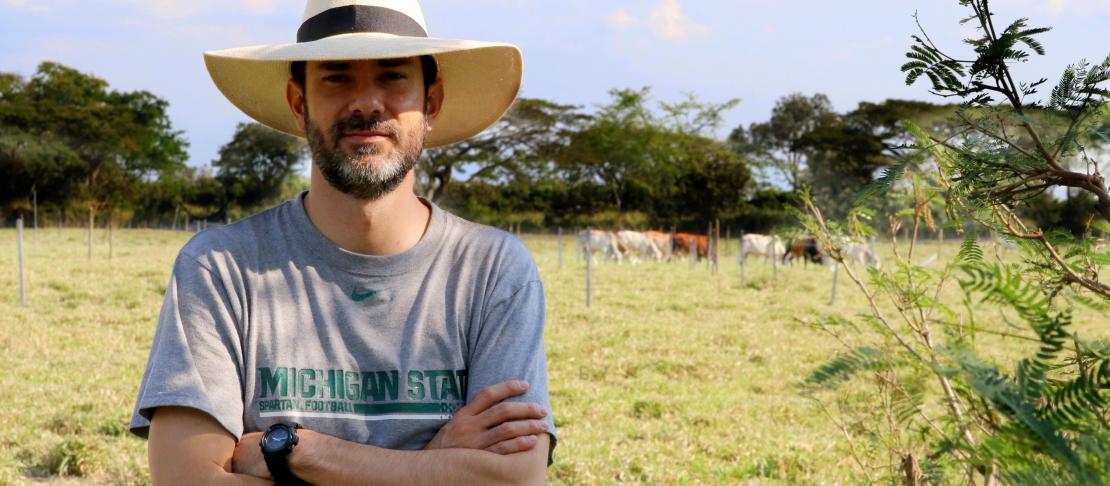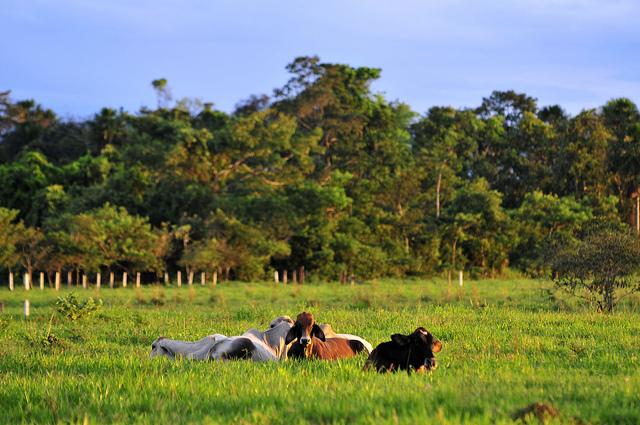Livestock and the challenges of climate change mitigation

Jacobo Arango, recently selected as a lead author for the Sixth Assessment Report of the Intergovernmental Panel on Climate Change (IPCC) and leader of the LivestockPlus project, talks to CCAFS Latin America about how we can mitigate greenhouse gas emissions in the livestock sector.
- Congratulations for the nomination as lead author! What will you work on with the IPCC?
Thank you, it’s a pleasure to join the team preparing the Sixth Assessment Report, which includes my colleagues, Ngoni Chirinda and Rolando Barahona, who were also chosen last year to contribute to other chapters of the report. I will work on the section about mitigation, revising which mitigation pathways are compatible with long-term goals. It is the same topic we are working on in the LivestockPlus project: seeing how we can increase productivity in the livestock sector, but with 20-30% less emissions than the current level.
2. How did you start working in this field?
I specialized in plant biology. After completing my PhD in Germany and working at a university in the US, I came back to the International Center for Tropical Agriculture (CIAT) in 2012. Here I started working with the Tropical Forages Program on projects that aim to reconcile livestock production with the environment. Livestock production should minimize its environmental impact when it comes to greenhouse gas emissions (GHG) and deforestation, as well as soil health and other ecosystem services.
3. How is your work connected to CCAFS Latin America?
For the last three years we have worked on the LivestockPlus project in Colombia and Costa Rica. In this project we aim to identify mitigation pathways—whether complex or simple, as livestock is one of the agricultural sectors with the highest GHG emissions. Only in Colombia, pastures for livestock represent the second most important type of land use in the country (over 30% of land) after forests, and more than 400,000 families depend exclusively on livestock. We also work in Costa Rica because the country has advanced in formulating and implementing Nationally Appropriate Mitigation Actions (NAMAs) for livestock and other sectors and can offer many lessons that Colombia and the region can tailor to meet their needs.
4. What are the mitigation challenges for Colombia's livestock? How can they be met?
Currently for a farmer it’s the same thing to produce a kilogram of meat with classic practices or low-emission methods, because we still do not have an incentive to adopt the latter. The challenge in the country is for the market to offer some kind of advantage to farmers who invest in or adopt mitigation methods, such as reduced tax or a premium price for products generated in a low-emission system.

Livestock in Los Llanos, Colombia. Photo: Neil Palmer
One of the main barriers is cost. For instance, if we compare silvo-pastoral systems with extensive pastures with to ones with few trees and shrubs that do not require much management, we can see that the first system involves greater initial investment to set up.
With producers, we don’t explain first how low-carbon management systems would help them reduce their emissions, but rather how these might help them to increase productivity, compared to extensive pastures—and how their activities can become more profitable and productive if they acquire a certain technology. At the moment, neither international bodies nor local authorities are using incentives for low-carbon silvopastoral systems.
That’s why we need to look at socio-cultural and economic aspects as well—if the producer doesn’t see a tangible benefit, the change will not be sustainable; we can write up projects and see the benefits throughout the life of that initiative, but once it’s over, so are the advantages.
5. What are the mitigation options you are exploring within LivestockPlus?
One very simple mitigation method is reorganizing grazing so that animals benefit from the best pastures and thus, emit less gases through rumination. Another one would be improving forages with plants such as Brachiaria, which reduces nitrous oxide emissions, a very potent greenhouse gas, through nitrification inhibition in soils, which takes place via interactions between these type of forages and soil microorganisms.
This and other methods can be adopted by small and large producers and that is an advantage in Colombia, where most farmers are small-scale.
6. How is the LivestockPlus project progressing?
In 2018 we finalize and we will have all the scientific information regarding the most appropriate ways to reduce greenhouse gas emissions—agro-management, pastoral and technological options that reduce emissions. These options will be tested in the lab, in the greenhouse, in the field and also on the farms. We are also supporting Colombia’s Ministry of Environment in producing a greenhouse gas inventory to improve emission measurements.
Colombia pledged to reduce its emissions by 20% in 2030 and has the potential to become an example for mitigation options. The country can be a model for its sustainable livestock technical committee, in existence for the last three years, led by the Ministry of Agriculture and Sustainable Development, as well as a model for mitigation methods implementation.
Read more:
- Project page: Supporting low emissions development in the Latin American cattle sector
- Info Note: Challenges and opportunities for the development of the NAMAs in the livestock sector in Colombia and Costa Rica
- Press release: The IPCC names Dr. Jacobo Arango as a lead author for its next Assessment Report
Alexandra Popescu is the communication officer for CCAFS Latin America.



